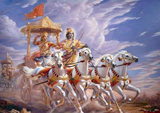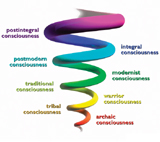Integral Health
The metaphysical basis for Integral Health — reconciling spirit and matter
A new synthesis of Spirit and Matter is the demand of the zeitgeist today. It is only then that spirituality will be effectual in material life and not just confined to ashrams and hermitages. However the reconciliation of Spirit and Matter is difficult to conceive as they represent two entirely different paradigms. The Spirit has been conceived by many spiritual stalwarts as silent, inactive, passive, detached, self-absorbed, self-existent and even as a supreme Nihil, a zero, a denial of reality, an absolute nothingness, an experience that can be facilitated if material life is considered to be illusory. How can such a blankness be reconciled with the turbulence, vitality and throb of material life? In fact, if such reconciliation were to have an effect in the realm of health, wouldn’t it be to encourage a passive acceptance of disease, a glorification of suffering, an eulogising of emaciation, a movement towards dissolution and death, an authentication of euthanasia?
However the Spirit has also been experientially perceived by many spiritual luminaries in diametrically opposite terms, as supremely active, powerful, glorified in absolute freedom and significantly meaningful and which gives credibility to material life. Sri Aurobindo explains that the passive and active realisations of the Spirit represent two poises of the same Reality. Moreover, it is precisely in the specific opposition between the two poises of Spiritual Reality and also in the general opposition between spiritual life and material life that the meaning of life has to be constructed and pursued: a venture that becomes relevant in all spheres of life but especially in the pragmatic fields of health and psychology.
The opposition between the two poises of spiritual reality
The opposition between the two poises of spiritual reality was solved by a synthetic realisation in the Gita by considering them to represent two poises of the same reality where each was relevant to the other. Sri Aurobindo explains that the passivity or silence supports the dynamism and the activity; it is the “eternal passivity which makes possible the perfect freedom and omnipotence of an eternal divine activity in innumerable cosmic systems (1).” It is from the bosom of the Mighty Silence that the perennial supply of cosmic energies emanate. Moreover the Silence supports impartially both the activity and the withdrawal of activity so that the soul or the individual being can cultivate the faculty of being free and detached even in the midst of the most intense action. This has not only relevance in an integral pursuit of spirituality but also in the pragmatic fields of health and psychology.
Thus is derived the rationale and possibility of developing the skills of silence and dynamism in a single individual as a self-growth discipline. Actually, the discordance between the inner silence and the outer activity is one of the important causes of psychosomatic and stress-linked maladies. A vigorous dynamism balanced by an inner poise, an ability to remain detached even in the thick of action helps to cope with stressors in a positive way without falling ill.
The opposition between spiritual life and material life
The opposition between spiritual life and material life is a far more difficult opposition than that between the two poises of spiritual reality and even cannot be reconciled by the great synthesis in the Gita. That is why Sri Aurobindo had to introduce a new integer of synthesis along the trajectory of a progressively evolving consciousness that not only allows the lower terms to proceed towards the higher but also concomitantly allows the higher terms to manifest in the matrix of the lower. In other words, Spirit itself can manifest in Matter. Spiritual realisations are based on Truth; there may be apparent differences between different poises of Truth but they can be still reconciled in the light of a deeper vision as after all, spirituality bases itself on the Unity-principle. However material life is based on the principle of endless divisibility which has lost the notion of Unity. It is thus based on falsehood in the sphere of personal growth, ignorance in the sphere of Light, suffering in the sphere of well-being and death in the sphere of Life. The only way left for a reconciliation between material life and spiritual life, between Matter and Spirit is a progressive evolution in consciousness and out of consciousness, a traversing of progressively higher ranges of an Integral Reality, a transformation and transmutation of the lower integers in terms of the higher, a successive unfolding of newer and higher potentials, a real adventure in consciousness.
An evolution in consciousness has the ability to bring forth higher models of the human being with newer potentials, newer capacities, newer cognitive faculties and even newer and more flexible modes of bodily functioning necessitating a progressive unfolding of innovative strategies in integral psychology and integral health.
Reference
1. Sri Aurobindo. Birth Centenary Library, Volume 18. Pondicherry: Sri Aurobindo Ashram Trust; 1970, pp. 26-7.
Share with us (Comments, contributions, opinions)
When reproducing this feature, please credit NAMAH, and give the byline. Please send us cuttings.


